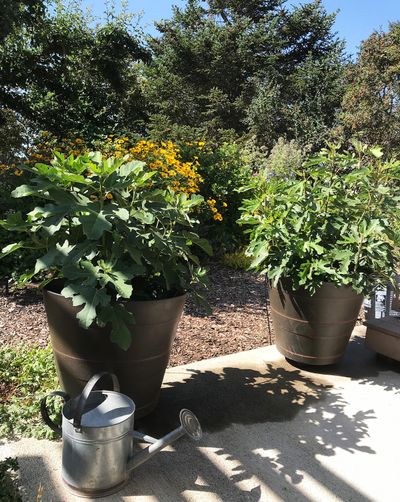In the Garden: With figs, it’s best to contain your excitement

I’ve been noticing a common trait among gardeners: We all love to push the envelope a bit. We regularly engage in what is known as zonal denial by purchasing plants that aren’t suited for our hardiness zone because we are certain those plants will happily grow in our own gardens if given plenty of tender loving care.
We also tend to be envious of gardeners in warmer zones who can grow fabulous plants such as artichokes and figs year-round. In my case, it just didn’t seem fair that folks on the West side could grow figs while it wasn’t even an option for Inland Northwest gardeners. At least, I thought it wasn’t.
In 2016, I spotted some hardy figs for sale in a plant catalog. The two cultivars, Chicago Hardy and Violette de Bordeaux, were listed as being hardy down to USDA zone 5. My husband, Bill, and I jumped at the chance to give them a try.
When the tiny plants arrived that spring, we carefully planted them on the south side of our small greenhouse. That seemed like a nice, sunny spot. They only grew a little that first summer, having more of a shrubby growth habit rather than being actual fig trees. As winter approached, we started feeling apprehensive. Would they make it through a Spokane winter?
The next spring, we discovered the plants had died back to the roots, but soon there were new sprouts coming up. We babied the plants through the growing season. In preparation for their second winter, we decided to mulch them heavily to provide insulation.
Once again, the plants survived but died back to the roots. We were starting to feel pretty discouraged. After all, if a plant is to fruit on branches, you need those branches to be alive in the spring.
In 2018, Bill and I visited some wonderful botanical gardens in England. At two of them, we noticed they were growing figs – and rather well, I might add. Wisley Gardens had a sign near their fig plantings that said, “They do best when the roots are restricted, in a container or in a ‘planting pit’ against a wall.” We saw a similar sign at the other garden.
That’s when the light bulb came on: Let’s grow them in large containers and move them into our garage during the winter. Last spring, we dug up the figs. We filled their pots with organic potting soil, watered them regularly and occasionally fed them with a balanced fertilizer. They spent the summer on a sunny patio. Violette de Bordeaux produced one tiny fig, which didn’t ripen in time, but it was a start.
Last fall, we waited until we had a hard frost and the figs dropped their leaves. After giving them a good watering, we moved them into the garage. During the winter, I checked on them monthly and watered them lightly so they wouldn’t dry out.
After moving them back outside this spring, I could see a bit of new growth at the base of the plants, but the branches appeared to be dead. I almost removed them but am so glad I didn’t. It turns out the branches are very slow to sprout new leaves in the spring. Soon, I was seeing those supposedly dead branches leafing out.
Maybe, just maybe, we’ll get some fruit this year. I will keep you posted.
Contact Susan Mulvihill at susan@susansinthegarden.com. Watch this week’s “Everyone Can Grow a Garden” video at youtube.com/c/susansinthegarden.